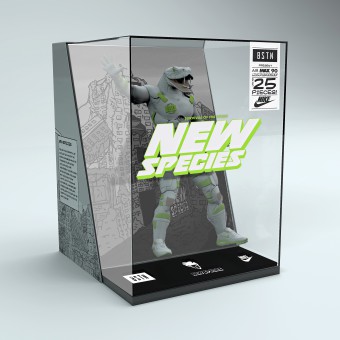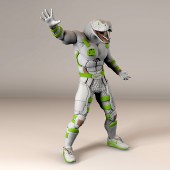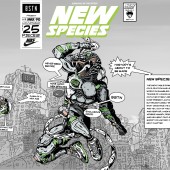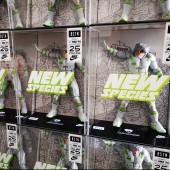
| THE AWARD |
| CATEGORIES |
| REGISTRATION |
| SUBMIT YOUR WORK |
| ENTRY INSTRUCTIONS |
| TERMS & CONDITIONS |
| PUBLICATIONS |
| DATES & FEES |
| METHODOLOGY |
| CONTACT |
| WINNERS |
| PRESS ROOM |
| GET INVOLVED |
| DESIGN PRIZE |
| DESIGN STORE |
| THE AWARD | JURY | CATEGORIES | REGISTRATION | PRESS | WINNERS | PUBLICATIONS | ENTRY INSTRUCTIONS |
Bstn Raffle Sneakers Box by Ralf Kauffmann |
Home > Winners > Design #112712 >Interview |
 |
|
FS: What is the main principle, idea and inspiration behind your design?
RK: For our client Nike, we very often design and produce seeding or influencer kits. This time the client gave us the task to develop a seeding box for a Nike shoe in a short time. This shoe had a snakeskin look and a bright green sole. In a short brainstorming session with the client, the idea of an action figure based on DC or Marvel heroes came up very quickly. We checked the options and the timing and got started very quickly. It was clear from the start that this hero would be a snakeman. The first sketches began with pencil, coordination rounds with the customer and after approval the implementation in 3D for later 3D printing. At the same time, we developed a short story, a comic and a suitable packaging made of plexiglass with a cardboard sleeve. After 5 weeks from the briefing, the 25 limited copies were delivered.
FS: What has been your main focus in designing this work? Especially what did you want to achieve?
RK: The main focus here was the transformation of the Sneakear into an action hero as a unique limited collector's figure with high desirability. The aim was to lay the foundation for collector figures for sneakerheads.
FS: What are your future plans for this award winning design?
RK: We will continue this design in adaptations. The principle and the packaging will be the same. The figures and design will of course be adapted to the next important Nike sneakers.
FS: How long did it take you to design this particular concept?
RK: A brainstorming session followed by a sketching phase was enough for the concept. As the time pressure was very high, the concept and scribble phase amounted to 2 days.
FS: Why did you design this particular concept? Was this design commissioned or did you decide to pursuit an inspiration?
RK: The concept came out of a brainstorming session as one of two options and was then requested and implemented by the client after a feasibility check. The inspiration was quite close and was only optimized in the process.
FS: Is your design being produced or used by another company, or do you plan to sell or lease the production rights or do you intent to produce your work yourself?
RK: The design was then produced with our partners. There were three other companies coordinated here. 3D printing company, a display manufacturer in conjunction with a packaging manufacturer.
FS: What made you design this particular type of work?
RK: The design and implementation was the best option for this project. Since we wanted to fire the collector's passion of sneakerheads, it was clear to us that we had to develop something that was not yet available in this form and context and should be very exclusive.
FS: Where there any other designs and/or designers that helped the influence the design of your work?
RK: Of course. Here, the designers from Marvel, DC and co. were clearly the inspiration. for the packaging, we were inspired by showcases in conjunction with a retail packaging.
FS: Who is the target customer for his design?
RK: Here, the so-called sneaker heads were addressed, which Beastin has as a large share of customers. Of course, every Nike fan was also addressed, especially since this action was played as a raffle.
FS: What sets this design apart from other similar or resembling concepts?
RK: The combination of uniqueness in this segment and the concept perfectly tailored to the product and the target group.
FS: How did you come up with the name for this design? What does it mean?
RK: The name was actually given. The retailer was Beastin in Munich (BSTN) in collaboration with Nike Germany and served for a sneaker raffle in the Beastin online store.
FS: Which design tools did you use when you were working on this project?
RK: Started with pencil and paper. Then Ilustrator worked out the fine details and prepared for Cinema 4D. Here the figure was final built for 3D printing and later the renderings for communication, packaging and other elements. Assembled in conjunction with Photoshop and Indesign for the packaging and other elements.
FS: What is the most unique aspect of your design?
RK: The design of the action hero and implementation in filigree 3D printing which was then painted by hand.
FS: Who did you collaborate with for this design? Did you work with people with technical / specialized skills?
RK: All elements were done in our agency from A to Z by different staff. This includes a freelancer specialist for 3D who is part of the staff and has his permanent workplace in-house.
FS: What is the role of technology in this particular design?
RK: In this design, 3D printing played a very important role. All other elements were made from plexiglass by CNC.
FS: Is your design influenced by data or analytical research in any way? What kind of research did you conduct for making this design?
RK: No research or market research data was used. However, we constantly observe the market very closely. What is currently in trend, where are the demands and how does the target group function. The implementation was very ambitious in terms of timing, so we relied on our many years of experience.
FS: What are some of the challenges you faced during the design/realization of your concept?
RK: The biggest challenge was definitely timing. A good five weeks from the initial brainstorming meeting to delivery left no wiggle room. The other big challenge was the attention to detail in 3D printing and painting. Here we challenged the printer.
FS: How did you decide to submit your design to an international design competition?
RK: By chance I came across the A'Award & Competition. When I saw what the categories are here, I thought I submit it times because it fits well to these criteria.
FS: What did you learn or how did you improve yourself during the designing of this work?
RK: We learned a lot about 3D printing and its requirements and possibilities. We learned a lot about the technical requirements and possibilities. This once again expands our portfolio of experience and possibilities that we can use for the future in communication.
FS: Any other things you would like to cover that have not been covered in these questions?
RK: I find that your questions 'provide the opportunity to look at all aspects and provide insight into this work. Therefore I have no further comments
FS: Thank you for providing us with this opportunity to interview you.
A' Design Award and Competitions grants rights to press members and bloggers to use parts of this interview. This interview is provided as it is; DesignPRWire and A' Design Award and Competitions cannot be held responsible for the answers given by participating designers.
| SOCIAL |
| + Add to Likes / Favorites | Send to My Email | Comment | View Press-Release | Translations |





